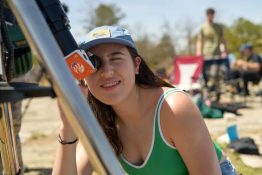Graduate students from the Department of Earth and Space Sciences at the University of Washington College of the Environment chased the March 2024 total solar eclipse across the Midwest — the last to be seen in the U.S. for the next 20 years.
Read more »Wolves’ return has had only small impact on deer populations in NE Washington
Wolves returned to Washington state in 2008. A new study shows that, despite their rising numbers, wolves are not having much of an impact on white-tailed deer, one of their primary prey. The biggest factor shaping white-tailed deer populations in northeast Washington is the quality of habitat available, which is largely determined by human activity.
Read more at UW News »S2 E7: eDNA with Ryan Kelly
In this episode of FieldSound, we hear from Ryan Kelly, professor in the School of Marine and Environmental Affairs. Trained as both an ecologist and a lawyer, Kelly brings a unique perspective to his research at the boundaries of marine science and real-world environmental law and policy. He works closely with federal agencies and currently serves on a national task force that aims to move science into practice at a federal level.
Read more »UW geoscience, marine and freshwater biology each rank in top 10 on new global ranking
The latest U.S. News & World Report listing of top-ranked universities in the world is out for 2024, and UW's marine and freshwater biology ranked No. 5 for subject rankings, and geosciences ranked No. 9. The University of Washington overall tied for No. 7 and maintained its No. 2 ranking among U.S. public institutions.
Read more at UW News »S2 E6: Shannon O'Donnell and the UW Dawgcast
In this episode of FieldSound, KOMO 4 Chief Meteorologist Shannon O’Donnell and University of Washington students speak about the formation of the UW Dawgcast, born out of ATM S 493: Media & Meteorology in the UW Department of Atmospheric Sciences. ATM S 493, which launched in 2020, is the first broadcast meteorology class offered on the West Coast. With it, the UW joins Pennsylvania State University and Mississippi State University as schools that offer broadcast meteorology instruction.
Read more »





